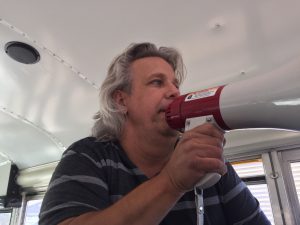
During the rowdy pipeline construction days, bars lined 4th Avenue in downtown Anchorage. Many of those establishments were surprisingly open to gay and lesbian Alaskans. On a bus tour this summer, passengers learned the role those places played in local LGBTQ history.
Myrna Lachoy stood at the front of a bus with a bull horn, pointing out the locations of old Anchorage bars. “It was so sleazy. It was so much fun!”
The passengers giggled at bawdy jokes and memories from 30 and 40 years ago, when bar culture was huge in Anchorage. They were on a tour of historical gay hotspots. Myrna pointed to the original Rendezvous Club in downtown.
“We had a lot of fun in that little place. It would hold 40 and we had 80 in it,” she recalled.
“That is on the bottom half,” chimed in Russ Reno, another tour guide for the night.
“Yeah, right,” Myrna countered.
The tour focused on the high points of gay life in the 1970s and 80s – the fun places to drink and do drugs. But Reno pointed out that there was a reason for the culture of escapism in the 1980s – the AIDS epidemic.
“How many people have at least five people on this bus that they consider friends?” he asked the crowd, who cheered in response.
“Now I’d like you to imagine for a second, without being too depressing here, think about what you would feel like after just maybe two years or three years and losing every single one of those friends, and maybe having yourself and one other left. And that’s what the 80s were all about.”
Reno said he gathered with others in bars because they were safe spaces, and they could party away their sadness.
Before AIDS, it was easier to be gay in Alaska, he said. People didn’t care as much about your sexual identity. They had the Gay Olympics and gay social organizations, like the Mount McKinley Non-Ascent Club. “We never went up, but we’ve been known to… well, you know the rest of that. We were a gentleman’s club.”

The small LGBT community even had political clout, he said, because just a few votes could change everything. “And we could organize relatively quickly, so we’d get people out there to vote. And we learned we could push the election in the direct we wanted it to go, so we became very political back in the day.”
But Reno says after the AIDS epidemic started, the general community and religious leaders became more homophobic.
Madeline Holdorf was at an annual celebration for the LGBT community and drag performers in 1982 when someone threw tear gas into the room.
“When that tear gas bomb went off, everyone thought it was part of an entrance, part of the show. And in fact it was tear gas. I was on the dias, which was part of the main stage. And everyone in the room moved at the same time.”
Despite the tear gas incident, Holdorf said for years, hundreds of people would turn out for the event. Part of the reason was that, unlike in other parts of the US, gay men and lesbians hung out together. They didn’t have things separate bars or clubs.
But now that the greater community is more accepting of LGBT people, the crowds at those events are much smaller. Holdorf said you don’t have to be in to bars or drag shows to find other gay people any more.
One of the bus tour organizers, Nicole Cundiff with Alaskans Together for Equality said that doesn’t mean the LGBT community has achieved equal rights.
“We have national marriage equality, and we have some non-discrimination ordinances in the state. But statewide we still don’t have LGBT protections, especially when it comes to our transgender population.”
Cundiff said that’s part of the reason why they organized the tour – so people would remember the city’s history and stay motivated to keep pushing for equal protections.
Anne Hillman is the healthy communities editor at Alaska Public Media and a host of Hometown, Alaska. Reach her at ahillman@alaskapublic.org. Read more about Anne here.





